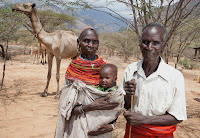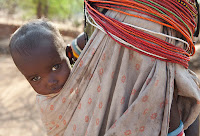Today is Blog Action Day 2011. It is also World Food Day. This year's theme for Blog Action Day is Food. Bloggers all over the world are writing about this one theme, from their own unique perspective. To find out more, visit the Blog Action Day website. Read more of our Blog Action Day posts on Heifer Blog here.Food. It’s a basic necessity. Nearly one billion people don’t have enough of it.
But right now, 13 million of those hungry happen to be in the Horn of Africa, an area which is experiencing its worst drought in 60 years. The drought, coupled with years of instability from armed conflicts that have prevented aid organizations from helping mitigate hunger, the area has been thrust into famine.
 |
| Mbaatian, her husband, Lmantasian, and Roniti |
We know, we know. You’ve heard us and a million others talking about it since July. So, why should you care? Because you can help do something about it. Right now.
Mbaatian Lemungat is a Heifer beneficiary who lives in the rural village of Ngurunit, Kenya. Not long ago her family received camels and training in their care.
But Mbaatian’s family hasn’t escaped the clutches of the drought. Her eldest daughter died after drinking contaminated water from one of the nearby wells that hasn’t yet dried up.
Mbaatian is now caring for her granddaughter, Roniti, who is also sick. Right now the camels are still providing milk that is helping supplement the nutrition the little girl needs. But without intervention to help keep the camels alive, Roniti may die, too.

Even though Heifer typically focuses on long-term results and not immediate relief aid, helping those in the Horn of Africa is a priority. Keeping their livestock alive keeps them alive.
We’re launching a project in the area where Mbaatian and her family live to assist those suffering from the drought. Our Families in Crisis Fund will help:
- Provide access to grass feed and veterinary drugs by purchasing and distributing 270 tons of grass hay and veterinary supplies to 2,600 Samburu pastoralists in Ngurunit, Arsim and Tuum locations as short term response.
- Provide access to water for both domestic (drinking water, hygiene & sanitation) and livestock consumption by constructing three water dams in Samburu district to serve more than 20,000 families and their livestock.
- Establish a fodder production enterprise through irrigation of 500 acres owned by 1,000 families in Garissa.
- Establish two community-owned facilities in Garissa irrigation scheme designed to handle 1,500 heads of cattle each at any one time for fattening and rearing heifers for replacement/restocking after the drought